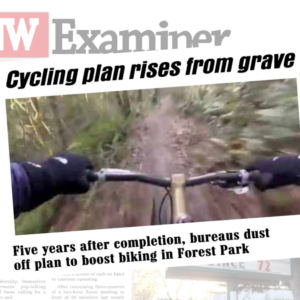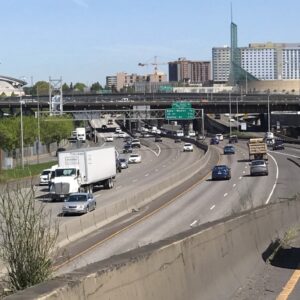Back in July I shared that the Oregon Department of Transportation (ODOT) had embarked on a major organizational shift with the creation of a new Active Transportation Section.
A memo from ODOT Director Matt Garrett sent to staffers on Tuesday, and a new page just published to their website, reveals that the agency is taking steps more steps in their effort to level the playing field for all modes of transportation. Put another way, they are — at long last — on a path to becoming a truly multi-modal agency.
“I want to challenge our current way of delivering services, so that can meet both our multi-modal and right-sizing expectations… This will be yet another example of that pioneering Oregon spirit.”
— Matt Garrett, Director of ODOT
According to sources at the agency, ODOT’s Highway Division will now be known as “Operations Division” and their “Highway Regions” will now be known as “Transportation Regions.” These are subtle shifts in nomenclature that symbolize a significant change: ODOT is re-structuring themselves in a way that will serve more multi-modal needs rather than being highway-focused.
Director Garrett prefaced an internal memo about the changes by saying, “As we strive to meet the expectations of the Oregon Transportation Commission and Governor Kitzhaber to become an agency that integrates policy and investment strategies across all modes of transportation, it is time for us to take another step forward.”
Here’s more form Garrett’s announcement (emphasis mine):
“ODOT has long delivered multimodal services through our divisions. In the past, however, our modes were within their own silos in the agency’s divisions. The challenge in front of us now, as we work to provide transportation options, is to create an organization that can speak with a holistic transportation voice and provide the transportation solutions that continue to move our state forward.”
It’s important to understand that Garrett’s motivation for these changes isn’t simply a new respect for biking, walking, and transit (although that is likely part of it): He sees re-organization and “right-sizing” of the agency as a money-saving step as well.
“I want to challenge our current way of delivering services,” wrote Garrett, “so that can meet both our multi-modal and right-sizing expectations.”
At its core, the “new vision for the organization,” Garrett is working toward is one that is centered around what he refers to “transportation functions rather than transportation modes.” In a nutshell, he is breaking down the silos that have existed at ODOT between the various transportation modes and funding programs. The net result of that an agency that has less of a highway-centric focus and one that gives a more powerful organization voice to multi-modal projects.
In a just-released FAQ about the new Active Transportation Section, ODOT explains that they are bringing several previously scattered programs and staffers under one roof.
“By co-locating programs such as Transportation Enhancement, Bicycle/Pedestrian, and Local Certification (which oversees many projects on local systems), we can better respond to the trends of lower revenue for transportation investments and changing needs of transportation users today and in the foreseeable future.”
So, as that excerpt reveals, ODOT isn’t saying they will start spending more on active transportation-centric projects, but they are trying to fund more — and better projects — with the limited funding available. It’s an attempt to be more nimble, savvy, and innovative in finding and spending money on projects that improve biking and walking access.
Another key aspect of these changes is that they are being made as part of an attempt to give equal priority to state and local projects.
What has also come to light is that over the next 1-2 years, ODOT will finalize major changes to its org chart. The process has already begun and one of the stated outcomes, according to Garrett’s memo (emphasis mine), is to “Create a decision making process that incorporates voices from both divisions and leads us to decisions that support all transportation, not any single mode.”
In reading the memo, it also seems like Garrett just might envision this new direction for ODOT as his legacy. Here’s how he phrases the last line:
“This is an exciting challenge and leadership opportunity. Oregon has been a national leader in transportation for a long time. This will be yet another example of that pioneering Oregon spirit.”
This is an exciting and evolving story. I plan to have a sit-down interview with Director Garrett during the Oregon Active Transportation Summit in Salem later this month to hear more about his motives and plans. Stay tuned and learn more at the Active Transportation Section pages on ODOT’s website.







Thanks for reading.
BikePortland has served this community with independent community journalism since 2005. We rely on subscriptions from readers like you to survive. Your financial support is vital in keeping this valuable resource alive and well.
Please subscribe today to strengthen and expand our work.
“Create a decision making process…leads us to decisions that support all transportation, not any single mode.”
If he means that, and sees this as a dynamically evolving process (non-single occupancy car traffic ascendant; single occupancy cars declining) then I think this should at some point in the near future also register as a change in ODOT’s attitude toward the CRC as outlined.
I look forward to your interview with Garrett.
1st step: “Right Size” the CRC!
Money that has already been wasted to replace a bridge that no current traffic projections shows a need for.
The next few hundred thousand dollars that is spent on the CRC needs to be the project justifying its future with Real Fact and not Scare Fact.
ODOT has to know that we can’t just throw $4+ billion down a hole just for the sake of jobs without said project being actually needed.
We’d get a much larger economic impact if we fully funded food stamp and public school programs.
Sweet. These changes may seem subtle but suggest a more philosophical shift underway in the agency as well and better align with the name of the agency itself, i.e., it isn’t the Department of Highways, or Department of Railways (or Bikeways, etc.). It’s the Department of Transportation. Good work.
Sorry, this makes two irrelevant comments in a row from me, but in the photo it looks like Garrett is holding a mysterious glowing light cupped in his hands. “With this light I will transform ODOT!”
No Rol, this is not irrelevant at all!! Your uncanny observations combined with mad daft wit are truly amazing and a joy to behold!!
Good work, indeed– I’m glad to see that ODOT is finally living up to it’s name. I’m looking forward to tangible change in the way ODOT takes care of its facilities, as well as better connectedness of the multi-modal system.
Curious why the Safe Routes to School program wasn’t moved under the Active Transportation umbrella….?
When ODOT stops building and expanding freeways down here in southern Oregon I’ll believe that there is a true change in the organization. So far they’ve been all about roads and facilitating sprawl down here.